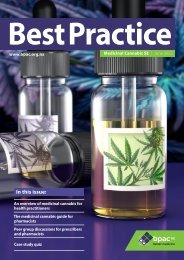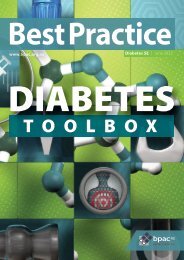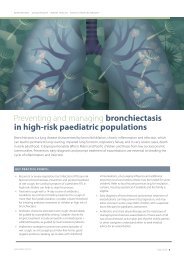Create successful ePaper yourself
Turn your PDF publications into a flip-book with our unique Google optimized e-Paper software.
oxycodone has increasingly been used as a drug of abuse. For<br />
example, the percentage of injecting drug users who had used<br />
oxycodone in the previous six months increased from 9% in<br />
2008 to 17% in 2016. 6<br />
The bpac nz message has been consistent<br />
In 2009, bpac nz first began urging prescribers to review their<br />
use of oxycodone, and since then we have published over 20<br />
articles, prescribing reports, clinical audits and peer group<br />
discussions focusing on the following key messages:<br />
Oxycodone is a strong opioid, approximately twice as<br />
potent as morphine<br />
There are few situations when a strong opioid should be<br />
initiated in primary care for the management of acute<br />
pain<br />
Morphine is the preferred first-line option when a strong<br />
opioid is indicated<br />
Oxycodone is rarely preferable to morphine because it<br />
has a similar adverse effect profile, is not more effective<br />
and may have more addictive potential<br />
Many clinicians have prescribed oxycodone in preference to<br />
morphine thinking that oxycodone is safer in patients with renal<br />
impairment. Fentanyl or methadone, however, are preferable<br />
options in this patient group, because unlike morphine and<br />
to a lesser extent oxycodone, neither have significant active<br />
metabolites.<br />
Are strong opioids necessary?<br />
Opioids are of little benefit in managing long-term nonmalignant<br />
pain. Typically, they are associated with a brief<br />
reduction in subjective pain before tolerance and hyperalgesia<br />
negate the benefit, leaving the patient neuro-adapted to a<br />
higher dose. In addition, constipation associated with opioids<br />
can be difficult to manage.<br />
Health professionals are recommended to form a treatment<br />
contract with patients before prescribing strong opioids. This<br />
agreement should cover the expected treatment duration,<br />
dose parameters, outcome measures, how to manage adverse<br />
effects and dates of review. Outcomes should be measurable<br />
by improvements in function, not subjective pain score – pain<br />
always eases with a dose increase, but temporarily, just as it<br />
always flares with a dose decrease, temporarily.<br />
Further information on the use of strong opioids is<br />
available from: “When to consider strong opioids for patients<br />
with acute pain” , https://bpac.org.nz/2018/opioids.aspx<br />
Information on withdrawing strong opioids and detecting<br />
potential drug seeking behaviour is available from: “Update<br />
on oxycodone: what can primary care do about the problem” ,<br />
https://bpac.org.nz/<strong>bpj</strong>/2012/may/oxycodone.aspx<br />
The Alcohol & Drug Helpline (0800 787 797) can advise<br />
on local availability of addiction support services and provides<br />
Māori, Pasifika and Youth helplines.<br />
Have we collectively made a difference?<br />
Oxycodone dispensing decreased substantially from 2011 to<br />
2015 and has remained at approximately the same level since<br />
then (Figure 1). Over the same time, however, dispensing of<br />
morphine increased and plateaued suggesting that while<br />
oxycodone may be being prescribed more appropriately, the<br />
use of strong opioids in New Zealand has increased.<br />
How prescribing of oxycodone has changed in New<br />
Zealand<br />
Prescribing of oxycodone by primary care clinicians has<br />
reduced substantially, which will have undoubtedly decreased<br />
opioid-related harms in New Zealand communities. Table 1<br />
shows that the proportion of patients initiated on oxycodone<br />
Figure 1: The number of<br />
patients in New Zealand<br />
dispensed oxycodone<br />
hydrochloride and<br />
50 000<br />
40 000<br />
30 000<br />
morphine (2011–2019) 7 20 000<br />
10 000<br />
0<br />
Morphine<br />
Oxycodone<br />
2011 2012 2013 2014 2015 2016 2017 2018 2019<br />
Year<br />
www.bpac.org.nz<br />
Best Practice Journal – SCE Issue 1 5









